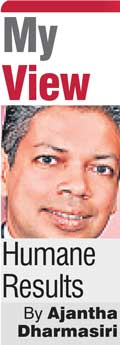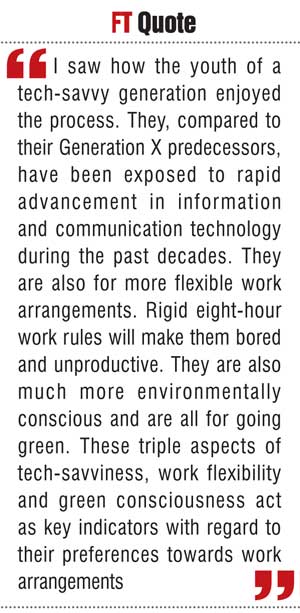Sunday Apr 20, 2025
Sunday Apr 20, 2025
Monday, 21 November 2016 00:01 - - {{hitsCtrl.values.hits}}
I was involved in two key recent global and local HR events. The annual conference of the Chartered Institute of Personnel and Development (CIPD), UK, was held at the Manchester Conventions Centre on 9 and 10 November. The other event was the Great HR Quiz 2016 organised by the Institute of Personnel Management (IPM), Sri Lanka, held on 16 November.
It was an impressive show of young talent with the participation of 53 teams representing key Sri Lankan corporates. Today’s column is a reflection of both of the above events in highlighting the growing recognition given to HR and the increasingly high impact created by HR.
Future of work
“Future of work is human”. That’s how Peter Chese, the CEO of CIPD, UK, summarised the overall theme of this year’s conference, attended by delegates from more than 40 countries. The need to shift from rigid processes to flexible work patterns that foster creativity and innovation was amply stressed.
 I was there at the CIPD conference representing the Institute of Personnel Management (IPM) Sri Lanka, in the capacity of the Honourary President. The CIPD Annual Conference and Exhibition is the one event in the year which HR professionals from around the world look forward to. There were more than 50 sessions on key HR topics with learnings from leading organisations across all sectors with the associated exhibition providing the latest HR solutions from more than 200 industry suppliers.
I was there at the CIPD conference representing the Institute of Personnel Management (IPM) Sri Lanka, in the capacity of the Honourary President. The CIPD Annual Conference and Exhibition is the one event in the year which HR professionals from around the world look forward to. There were more than 50 sessions on key HR topics with learnings from leading organisations across all sectors with the associated exhibition providing the latest HR solutions from more than 200 industry suppliers.
There were four conference streams associated with the event which the participants could choose.
1. Insights on changing context: Understand business change, external factors and how to adapt HR to changing workforce practices.
2. HR essentials and learning processes - Develop evidence-based HR strategies to provide better business value.
3. Business, commercial insight and analytics - Explore the latest issues that will help oneself to maximise the capabilities of the HR function.
4. Science of human behaviour - Understand employee behaviours to increase people performance.
Five session formats were involved in each of the streams. Keynote was the first format which consisted of inspirational insights from leading HR and business experts. Panel Discussion was the second format covering hot topics in HR with vibrant arguments and counterarguments.
Workshop was the third format with practical, hands-on sessions such as how to design a performance management system. Case Study was the fourth format where leading organisations shared their experiences. Masterclass was the final format where cutting-edge strategic ideas from leading business practitioners were involved.
I personally preferred the Masterclass format where there was ample time for knowledge sharing as well as for a question and answer session.
HR as a connector and a collaborator
The keynote speaker at the inauguration was Entrepreneur, CEO and author Ms. Heffernan, of Ted.com fame. She, through numerous examples, emphasised the importance of super teams over super individuals working in isolation. She encouraged HR to continue to work collegiately, connect and break down barriers by building social capital and adaptive businesses.
The endnote speech has always been a memorable feature of the conference. Associate Professor of Organisational Behaviour at INSEAD, Gianpiero Petriglieri, skillfully tied up the key themes from the conference with a look at mobility, success and the role of HR in creating trustworthy leadership. ‘Leadership is living a story’, that is how the richness of leadership is simply amplified.
Among many other sessions, the diverse dimensions of HR with practical implications were intensely highlighted. The presence of professionals and professors alike in sharing the depth and breadth related to the future of work was significant. In essence, the overall experience was the high impact HR can create and should create in the typical workforce.
From global to local
Great HR Quiz 2016, the third of its kind, was a key connector of talented youth. In bringing HRM to the forefront, initiatives of this nature occupy a prominent place. The necessity of finance for an organisation is much easier to understand than the need to have the right person in the right place.
HRM is slowly coming from the tap to the top. There is more emphasis on people matters in the boardrooms through subcommittees and this is an encouraging sign.
Ajantha Dharmasiri with Peter Cheese, the CEO of CIPD, UK
The key feature of the HR Quiz was the enthusiasm and engagement of the young employees representing their institutions. Most of them were millennials with a winning attitude. Being Generation Y employees who were born between 1980 and 1999 meant they had differences in their perceptions, preferences and performance. They were not necessarily from the department of HRM. The spirit of actions and the synergy of interactions were indeed significant. It was a battle of the brains with regard to people management.
The use of technology has been a remarkable feature of the HR Quiz. The summarised responses of each team were relayed within seconds and the results were displayed on the wide screen in an efficient manner.
There was a wide range of questions from various aspects of HRM. Also there were questions on current affairs and sports. Some questions were easy and others were tough. There were questions based on brief video clippings as well. One noteworthy feature I saw was the inclusion of situation-related questions that were highly application-oriented. All in all, it was an enriching endeavour.
I saw how the youth of a tech-savvy generation enjoyed the process. They, compared to their Generation X predecessors, have been exposed to rapid advancement in information and communication technology during the past decades. They are also for more flexible work arrangements. Rigid eight-hour work rules will make them bored and unproductive. They are also much more environmentally conscious and are all for going green. These triple aspects of tech-savviness, work flexibility and green consciousness act as key indicators with regard to their preferences towards work arrangements.
The spirited cheer whenever a team got the right answer was very evident. As the quiz progressed from round one to two and so on  till the final round, the energy level among the participants was on the rise, demonstrated through their applause. Questions for the audience also added variety to the HR Quiz.
till the final round, the energy level among the participants was on the rise, demonstrated through their applause. Questions for the audience also added variety to the HR Quiz.
From awareness to awesome results
We are witnessing a growing awareness among the corporate fraternity over HRM’s various aspects. This welcome sign should be properly nurtured to ensure a rich harvest of human potential. People are being increasingly recognised as a factor that gives a competitive advantage.
As has always been the case, the private sector, with much influence from multinational corporations, has spearheaded best practices in HR. The public sector is sadly lagging behind with the overly emphasised domain of administration, neglecting the learning and development aspects. It appears as an interesting case where the engine of growth (private sector) has better people practices than the so-called driver of the engine (public sector).
People development cannot take a back seat if we are to grow as a nation. Sound practices of strategic HRM will be one sure way forward in ensuring the balance between organisational goal attainment and employee development.
It is worthwhile to recollect the way we defined HRM for Sri Lanka. Based on the brainstorming we had as a team and the feedback obtained from professionals and professors, the following definition emerged: “A strategic and integrated approach in acquisition, development and engagement of talent, using relevant tools, with proper policies, practices and processes in creating a conducive climate towards achieving organisational excellence and societal wellbeing (IPM, 2014).”
What we mean by strategic is working towards achieving the overall goals and specific objectives of the organisation. It is essentially aligning with broad organisational priorities. It highlights the strategic significance of HRM and the holistic role it should play.
The end result of all HR endeavours, the way we see it, has twin aspects: organisational excellence and societal wellbeing. What we mean by organisational excellence is its overall performance with continuous improvement. It obviously includes financial results, customer satisfaction, process efficiency and people development, the four perspectives of a typical balanced scorecard.
HR professionals cannot function in isolation ignoring social realities. This is more relevant to a developing country like ours, where issues such as poverty, unemployment and ethnic tensions cannot be ignored. That’s why we included societal wellbeing as a key outcome of HRM. It highlights the need to support people outside the organisation and protect the environment as well.
Having clarity on the identity of HRM is a step towards delivering sustained results. Now we need to put the acts together in ensuring awareness, appreciation and application among Sri Lankan HR Professionals.
Road ahead
The CIPD Conference on HR on the theme, ‘Future of Work’ highlighted the high impact of HR. The HR Quiz 2016 on the other hand, with 53 teams, created motivating momentum for the people managers to engage in an intellectually stimulating and interactional experience.
The positive vibrations of the precious value of HRM emanated at the HR Quiz 2016 were encouraging to the decision-makers. The need to be more professional in making people management decisions across a wide cross-section of society has been already felt. In essence, HRM should be practised in both the private and public sectors for better results.
(Prof. Ajantha Dharmasiri can be reached through [email protected], [email protected] or www.ajanthadharmasiri.info.)
Discover Kapruka, the leading online shopping platform in Sri Lanka, where you can conveniently send Gifts and Flowers to your loved ones for any event including Valentine ’s Day. Explore a wide range of popular Shopping Categories on Kapruka, including Toys, Groceries, Electronics, Birthday Cakes, Fruits, Chocolates, Flower Bouquets, Clothing, Watches, Lingerie, Gift Sets and Jewellery. Also if you’re interested in selling with Kapruka, Partner Central by Kapruka is the best solution to start with. Moreover, through Kapruka Global Shop, you can also enjoy the convenience of purchasing products from renowned platforms like Amazon and eBay and have them delivered to Sri Lanka.
Discover Kapruka, the leading online shopping platform in Sri Lanka, where you can conveniently send Gifts and Flowers to your loved ones for any event including Valentine ’s Day. Explore a wide range of popular Shopping Categories on Kapruka, including Toys, Groceries, Electronics, Birthday Cakes, Fruits, Chocolates, Flower Bouquets, Clothing, Watches, Lingerie, Gift Sets and Jewellery. Also if you’re interested in selling with Kapruka, Partner Central by Kapruka is the best solution to start with. Moreover, through Kapruka Global Shop, you can also enjoy the convenience of purchasing products from renowned platforms like Amazon and eBay and have them delivered to Sri Lanka.